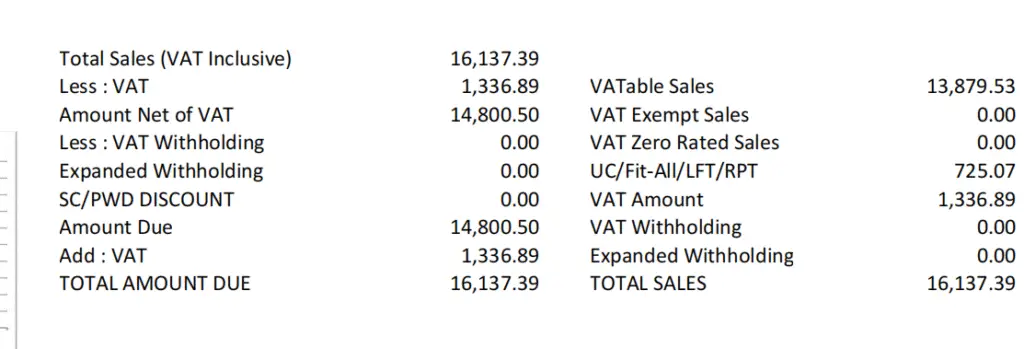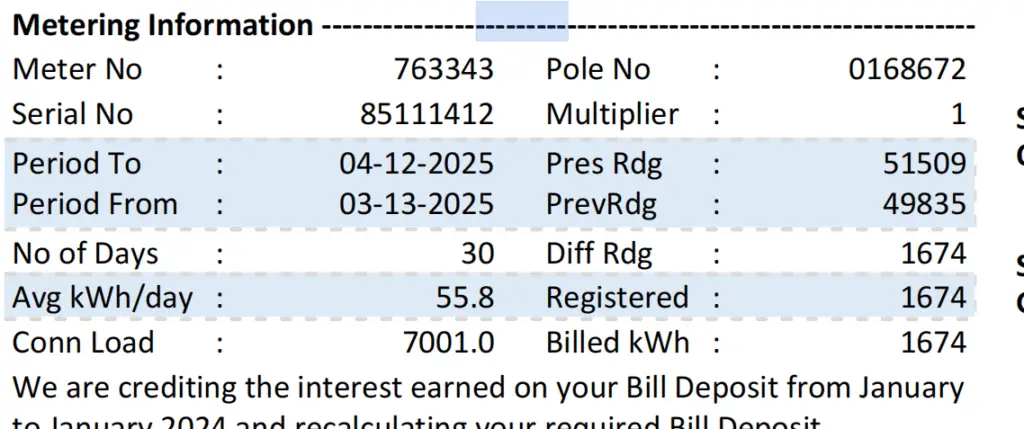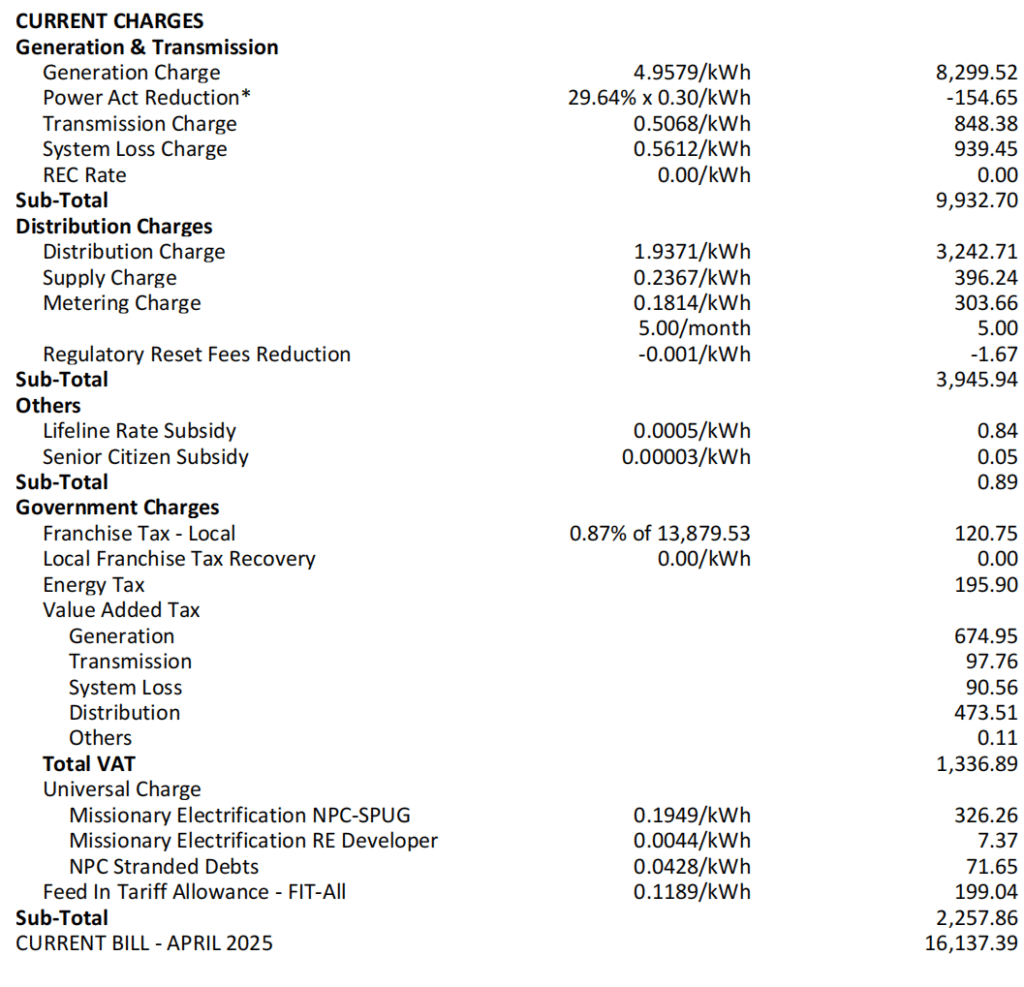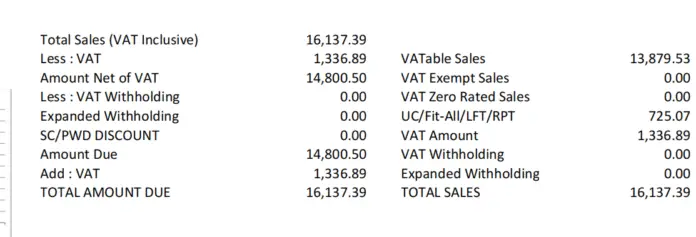
This is the result of out Experiment of the household appliance use. 4 units of a/c. 2 of which is running 24/7.
Using a sample April 2025 billing statement from Davao Light and Power Company (DLPC) as a springboard, we will walk through every section—from meter readings to universal charges—translate technical jargon into plain English, and finish with practical tips to keep your consumption (and stress level) in check. Along the way, we will note recent rate movements in Davao and national policy shifts so you can see the bigger picture behind the peso signs.
(All figures quoted from the sample are rounded to the nearest centavo. Personal identifiers such as names and addresses have been removed to protect privacy.)
Every DLPC invoice has three information

| Section | Why It Matters | Key Take-Aways in the April 2025 Sample |
|---|---|---|
| Account & Billing Info | Tells you the billing month, statement date, and payment deadline. | • Statement Date: 12 April 2025 • Due Date: 24 April 2025 |
| Customer & Premise Data | Links consumption to a specific service address and meter. | • Meter No. ends with 343 • Serial No. ends with 12 |
| Metering Details | Shows how DLPC derived your kilowatt-hour (kWh) usage. | • Reading Period: 13 Mar – 12 Apr 2025 (30 days) • Previous Reading: 49,835 • Present Reading: 51,509 • Consumption: 1,674 kWh • Daily Average: 55.8 kWh |
At a national level, Filipino households average roughly 200 kWh per month. Our sample household therefore consumes about eight times the norm—an important clue later when we discuss energy-saving opportunities.
2. Generation & Transmission Charges (₱9,932.70)
2.1 Generation Charge – ₱8,299.52
This is the single largest component of any Philippine electric bill. It reflects the blended cost DLPC pays to power producers for the electricity you eventually use. Fuel prices, power-plant outages, and wholesale spot-market swings all feed into this figure.
- Rate in April 2025: ₱4.9579 per kWh
- Why the number moved: DLPC disclosed a slight uptick in its overall residential tariff for the April 11 – May 11, 2025 billing cycle, driven by higher generation costs. (Davao Light and Power Co. – Facebook)
2.2 Power Act Reduction – ₱-154.65
Stemmed from Republic Act 9136 (EPIRA), this line refunds a portion of generation costs to qualified customers.
2.3 Transmission Charge – ₱848.38
Paid to the National Grid Corporation of the Philippines (NGCP) for wheeling electricity from distant power plants to Davao. It varies by kWh usage and NGCP-approved tariffs.
2.4 System Loss Charge – ₱939.45
Covers energy lost in wires and transformers during delivery. The Energy Regulatory Commission (ERC) caps recoverable losses at 8.25 % for private distribution utilities.
3. Distribution-Related Charges (₱3,945.94)
These stay with DLPC and fund infrastructure, staff, meters, and customer service.
| Sub-Charge | Rate | Amount |
|---|---|---|
| Distribution | ₱1.9371 /kWh | ₱3,242.71 |
| Supply | ₱0.2367 /kWh | ₱396.24 |
| Metering | ₱0.1814 /kWh | ₱303.66 |
| Metering Reading Fee | ₱5.00 /mo | ₱5.00 |
| Regulatory Reset Reduction | –₱0.001 /kWh | –₱1.67 |
Why these matter: Unlike generation and transmission, distribution rates are relatively stable over a three- to five-year regulatory period, but they can still change after a formal ERC “reset.”
A February 2025 DLPC advisory pegged its total residential distribution-supply-metering bundle at about ₱2.355 /kWh—higher than a neighboring cooperative’s ₱1.537 /kWh, a contentious point in Congress debates about franchise expansion. (Nordeco opposes House bill expanding Davao Light’s coverage area)
4. “Others” Section (₱0.89)
Tiny yet symbolically important, these lines capture cross-subsidies:
- Lifeline Rate Subsidy: Helps marginalized consumers (≤100 kWh/month) pay lower bills.
- Senior Citizen Subsidy: Discounts mandated under R.A. 9994.
Our sample household is ineligible—its usage is far above the lifeline threshold—so it instead contributes ₱0.89 to fund discounts for qualified neighbors.
5. Government-Imposed Charges (₱2,257.86)
5.1 Local Franchise Tax – ₱120.75
A levy by the city where the franchise operates, computed as a percent of gross revenues.
5.2 Energy Tax – ₱195.90
A national tax applied per kWh on all electricity sales.
5.3 Value-Added Tax (VAT) – ₱1,336.89
All vatable components (generation, transmission, distribution, system loss, “others”) are multiplied by 12 %. Because VAT is percentage-based, higher consumption means higher VAT, regardless of the base rates.
5.4 Universal Charges & FIT-All – ₱604.32
These fund missionary electrification, NPC stranded debts, and incentives for renewable-energy developers. The Universal Charge–Missionary Electrification (UC-ME) alone clocks in at ₱333.63 in our sample bill.
Recent Department of Energy (DOE) circulars emphasize transparency in these pass-through items to help consumers understand why generation costs dominate their bills. (DOE pushes for a Streamlined CSP for the Benefit of the Consumers)
6. Crunching the Effective Rate
To gauge whether your household is paying more (or less) than the citywide average, divide TOTAL CURRENT BILL by kWh consumed:
₱16,137.39 ÷ 1,674 kWh ≈ ₱9.64 / kWh
Compare that with DLPC’s headline residential rate for the same period—about ₱9.49 /kWh—and you see a ₱0.15 premium. Why? Additional VAT and local franchise tax push the blended cost above the advertized “all-in rate.”
In January 2025, DLPC published an ₱8.99 /kWh all-in rate after a drop in generation charges, showing how volatile the effective rate can be month to month. (Davao Light Rate is Down at P8.99/kWh this January 2025 – South …)

7. Why Electricity Rates Fluctuate
- Fuel Prices: Coal and natural-gas contracts adjust quarterly; higher import costs ripple into generation charges.
- Wholesale Electricity Spot Market (WESM): When contracted baseload is short, DLPC buys from the spot market, often at higher prices.
- Currency Exchange: Power producers pay for imported coal in US dollars; a weaker peso raises peso-denominated charges.
- Weather Events: El Niño reduces hydro output, forcing utilities to dispatch more expensive thermal plants.
- Regulatory Adjustments: ERC resets for distribution utilities and periodic VAT or UC-ME recalculations can nudge rates up or down.
8. Reading Your Meter Like a Pro
Digital meters used by DLPC display cumulative kWh usage. If the meter reads 51,509 today and 51,709 a week later, that weekly draw is 200 kWh. At ₱9.50/kWh, that’s roughly ₱1,900—a quick budgeting hack long before the bill arrives.
Many homeowners install sub-meters for rental rooms or sari-sari stores to pinpoint energy hogs. DLPC’s Customer Service can assist in validating such setups, ensuring they comply with technical standards.
9. Seven High-Impact Ways to Lower Your Bill
9.1 Attack Standby Loads
Devices in “sleep” mode still sip power. A smart strip can cut idle consumption by up to 10 % for electronics-heavy households.
9.2 Optimize Air-Conditioner Settings
For every 1 °C increase in thermostat setting, cooling costs drop about 7 %. Regularly cleaning filters maintains efficiency.
9.3 Retire Old Refrigerators
A 1990s 10-cu-ft ref may use 1.2 kWh/day more than an inverter model. Over a year that’s ₱4,000 in extra charges—enough to finance a new appliance via installment.
9.4 Shift Heavy Loads Off-Peak
While DLPC’s residential tariff is flat-rate, future time-of-use (TOU) programs may reward nighttime laundry or dishwashing. Training your routine now builds good habits.
9.5 Leverage Natural Ventilation
Mindfully opening windows in early morning and late evening can delay air-con use by hours.
9.6 Install LED Bulbs and Motion Sensors
Swapping ten 60 W incandescent bulbs for 9 W LEDs saves ≈150 kWh/month—about ₱1,450. Motion sensors curb hallway and porch waste.
9.7 Explore Net-Metering or Rooftop Solar
Under Philippine Net-Metering rules, DLPC credits excess solar output at the blended generation cost, shrinking your daytime draw. (1. How Net-Metering works: understanding the basics of policy …)
10. Programs That Ease the Pain
| Program | Who Qualifies | Benefit |
|---|---|---|
| Lifeline Rate | Households ≤100 kWh/mo & income below the poverty threshold | 20 – 100 % discount on generation & distribution charges |
| Senior Citizen Discount | Resident senior citizen is the registered account holder; consumption ≤100 kWh | 5 % discount on the first 100 kWh |
| Anti-Bill Shock Installment | Consumers facing atypically high bills after rate spikes | Pay incremental portion over 3-6 months (Tap ANTI BILL SHOCK Lending Program to make electricity rates …) |
| Bill Deposit Interest Credit | All customers with bill deposits | Annual interest either credited to future bills or refunded if deposit exceeds 110 % of average bill |
Take advantage: Verification requires proof of income (for lifeline) or age (for seniors); visit any DLPC office or email their customer desk to apply.
11. Digital Tools: ORUS, Mobile Apps, and E-Bills
DLPC’s Online Retailer Utility System (ORUS) lets you download certificates of registration (CoRs), track payment history, and print duplicate bills—convenient for landlords and home-based entrepreneurs. E-billing minimizes the risk of lost statements and lets you set automatic reminders days before the due date.
Pro-tip: Pair ORUS alerts with a mobile banking auto-debit to avoid late-payment surcharges, which are 2 % per month on unpaid balances.
12. What to Do When Your Bill Looks Wrong
- Compare Meter Readings: Check if the “present reading” aligns with your own meter snapshot near the cut-off date.
- Audit kWh Consumption: Has usage surged without lifestyle changes? Appliances may have gone faulty, or a neighbor could be tapping illegally into service lines.
- File a Formal Query: DLPC must act on written complaints within 7 working days for metering issues or 5 days for billing disputes under ERC rules.
- Request Meter Testing: If you suspect a malfunction, DLPC will replace the unit and send the old meter to ERC-accredited labs. Fees are waived if the meter is indeed inaccurate.
13. The Bigger Picture: Policy Trends Shaping Future Bills
- Expanded Franchise Areas: Congressional bills aim to broaden DLPC’s service footprint. Opponents argue higher distribution charges could follow. (Nordeco opposes House bill expanding Davao Light’s coverage area)
- Renewable Portfolio Standards (RPS): Utilities must source an increasing share from renewables, potentially lowering long-term generation costs but requiring upfront grid investments.
- Revised CSP Rules (2025 Draft): A Department of Energy circular seeks more transparent competitive bidding for power supply agreements, promising consumer savings. ([PDF] DEPARTMENT CIRCULAR NO. DC2025)
- Distributed Energy and Storage: As battery costs fall, future net-metering reforms may credit excess solar at wholesale rather than blended generation rates, boosting payback periods for prosumers.
14. Frequently Asked Questions
Q 1: Does unplugging chargers really save money?
A: A single idle phone charger draws ~0.1 W. That is only ₱0.04/month. But a household with ten such “vampire” devices—modems, consoles, microwave clocks—can lose ₱50–100 monthly.
Q 2: Is it cheaper to leave an air-con on low all day or cycle it?
A: Cycling is cheaper; inverter compressors ramp down but never truly switch off, so eight hours of continuous low cooling still outweighs 3-4 hours timed around peak heat.
Q 3: Why do I pay VAT on system loss?
A: The Tax Code treats system loss as part of “sale of electricity.” Every peso flowing through the meter—even losses—is vatable. ERC has upheld this interpretation in multiple rulings.
15. Action Plan Checklist
- Download Last 12 Months of Bills and chart consumption trends.
- Set a Weekly Meter Snapshot reminder on your phone.
- Replace High-Impact Appliances (old fridge, non-inverter AC).
- Apply for Applicable Subsidies (lifeline, senior citizen).
- Explore Rooftop Solar Quotations; compare payback with rising generation costs.
- Attend DLPC Public Consultations or track ERC dockets to voice rate concerns.
Turn Knowledge into Savings
Understanding an electric bill can feel like deciphering a foreign language. Yet every line tells a story—of global fuel markets, government policy, and personal habits under your roof. By dissecting an actual April 2025 Davao Light statement, we have followed the money from power plant to socket and uncovered dozens of levers a savvy consumer can pull.
Next time your envelope—or email notification—arrives, don’t just glance at the total. Ask:
- Did I use more kWh or did rates rise?
- Which charge can I influence?
- What programs am I leaving on the table?
The answers could be worth thousands of pesos a year. And with that, you will have transformed the monthly ritual of paying a bill into an empowering exercise in energy literacy. Happy saving!
